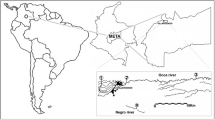Abstract
Complex effluents originating from diverse industrial processes in industrial zones could pose cytotoxic/genotoxic hazards to biota in the receiving ecosystems which cannot be revealed by conventional monitoring methods. This study assessed potential cytotoxicity/genotoxicity of treated effluents of two industrial zones which are discharged into Kelani river, Sri Lanka combining erythrocytic abnormality tests and comet assay of the tropical model fish, Nile tilapia. Exposure of fish to the effluents induced erythrocytic DNA damage and deformed erythrocytes with serrated membranes, vacuolations, nuclear buds and micronuclei showing cytotoxic/genotoxic hazards in all cases. Occasional exceedance of industrial effluent discharge regulatory limits was noted for color and lead which may have contributed to the observed cytotoxicity/genotoxicity of effluents. The results demonstrate that fish erythrocytic responses could be used as effective bioanalytical tools for cytotoxic/genotoxic hazard assessments of complex effluents of industrial zones for optimization of the waste treatment process in order to reduce biological impacts.


Similar content being viewed by others
References
Al-Sabti K, Metcalfe CD (1995) Fish micronuclei for assessing genotoxicity in water. Mutat Res 343:121–135
BOI (2011) Board of Investment, Sri Lanka: environmental norms. http://www.investsrilanka.com/images/publications/pdf/environmental_norms.pdf, Accessed 13 April 2017
Canalejo A, Diaz-de-Alba M, Granado-Castro MD, Cordoba F, Espada-Bellido E, Galindo-Riaño MD, Torronteras R (2016) Early genotoxic response and accumulation induced by waterborne copper, lead, and arsenic in European seabass, Dicentrarchus labrax. Environ Sci Pollut Res 23:3256–3266
Collins AR, Oscoz AA, Brunborg G, Gaivao I, Giovannelli L, Kruszewski M, Smith CC, Stetina R (2008) The comet assay: topical issues. Mutagenesis 23:143–151
Correia JE, Christofoletti CA, Ansoar-Rodríguez Y, Guedes TA, Fontanetti CS (2017) Comet assay and micronucleus tests on Oreochromis niloticus (Perciforme: Cichlidae) exposed to raw sugarcane vinasse and to physicochemical treated vinasse by pH adjustment with lime (CaO). Chemosphere 173:494–501
de Lima ROA, Bazo AP, Salvadori DMF, Rech CM, Oliveira DdeP, Umbuzeiro GdeA (2007) Mutagenic and carcinogenic potential of a textile azo dye processing plant effluent that impacts a drinking water source. Mutat Res 626:53–60
Eaton AD, Clesceri LS, Rice EW, Greenberg AE (2005) Standard Methods for the Examination of Water and Wastewater. Centennial Edition. American Public Health Association, Washington, D.C.
GOSL (2008) The Gazette of the Democratic Socialistic Republic of Sri Lanka (Extraordinary) 1534/18: National Environmental (Protection and Quality) Regulations, No. 1 of 2008
Heddle JA, Cimino MC, Hayashi M, Romagna F, Shelby MD, Tucker JD, Vanparys P, MacGregor JT (1991) Micronuclei as an index of cytogenic damage: past, present and future. Environ Mol Mutagen 18:277–291
Hemachandra CK, Pathiratne A (2016) Combination of physico-chemical analysis, Allium cepa test system and Oreochromis niloticus erythrocyte based comet assay/nuclear abnormalities tests for cyto-genotoxicity assessments of treated effluents discharged from textile industries. Ecotoxicol Environ Saf 131:54–64
Hemachandra CK, Pathiratne A (2017) Cytogenotoxicity screening of source water, wastewater and treated water of drinking water treatment plants using two in vivo test systems: Allium cepa root based and Nile tilapia erythrocyte based tests. Water Res 108:320–329
Hintzsche H, Hemmann U, Poth A, Utesch D, Lott J, Stopper H (2017) Fate of micronuclei and micronucleated cells. Mutat Res 771:85–98
Kumar P, Kumar R, Nagpure NS, Nautiyal P, Dabas A, Kushwaha B, Lakra WS (2012) Genotoxic and mutagenic assessment of hexavalent chromium in fish following in vivo chronic exposure. Hum Ecol Risk Assess 18:855–870
Oliveira DP, Carneiro PA, Sakagami MK, Zanoni MVB, Umbuzeiro GA (2007) Chemical characterization of a dye processing plant effluent: identification of the mutagenic components. Mutat Res 626:135–142
Papa M, Ceretti E, Viola GCV, Feretti D, Zerbini I, Mazzoleni G, Steimberg N, Pedrazzani R, Bertanza G (2016) The assessment of WWTP performance: towards a jigsaw puzzle evaluation? Chemosphere 145:291–300
Pathiratne A, Hemachandra CK, De Silva N (2015) Efficacy of Allium cepa test system for screening cytotoxicity and genotoxicity of industrial effluents originated from different industrial activities. Environ Monit Assess 187:730. doi:10.1007/s10661-015-4954-z
Prasse C, Stalter D, Schulte-Oehlmann U, Oehlmann J, Ternes TA (2015) Spoilt for choice: a critical review on the chemical and biological assessment of current wastewater treatment technologies. Water Res 87:237–270
Walia GK, Handa D, Kaur H, Kalotra R (2013) Erythrocyte abnormalities in a freshwater fish Labeo rohita exposed to tannery industry effluent. Int J Pharmacol Biological Sci 3:283–295
Water Environment Partnership in Asia (WEPA) (2015) WEPA policies-state of water environment, water-related issues and policies. http://wepa-db.net/policies/top.htm. Accessed 23 October 2015
Wieczerzak M, Namieśnik J, Kudłak B (2016) Bioassays as one of the green chemistry tools for assessing environmental quality: a review. Environ Int 94:341–361
Zar JH (1999) Biostatistical analysis. Prentice Hall, New Jersey
Acknowledgements
This research was funded by the National Research Council (Research Grant: 11-11) and National Science Foundation (Equipment Grant: RG/2011/EQ/16) of Sri Lanka.
Author information
Authors and Affiliations
Corresponding author
Ethics declarations
Conflict of interest
The authors declare that they have no conflict of interest.
Ethical Approval
All applicable international guidelines for the care and use of animals were followed in relation to the laboratory maintenance and bioassessment with the fish.
Informed Consent
Informed consent is not applicable in this study.
Rights and permissions
About this article
Cite this article
Hemachandra, C.K., Pathiratne, A. Bioassessment of the Effluents Discharged from Two Export Oriented Industrial Zones Located in Kelani River Basin, Sri Lanka Using Erythrocytic Responses of the Fish, Nile Tilapia (Oreochromis niloticus). Bull Environ Contam Toxicol 99, 481–487 (2017). https://doi.org/10.1007/s00128-017-2156-9
Received:
Accepted:
Published:
Issue Date:
DOI: https://doi.org/10.1007/s00128-017-2156-9




